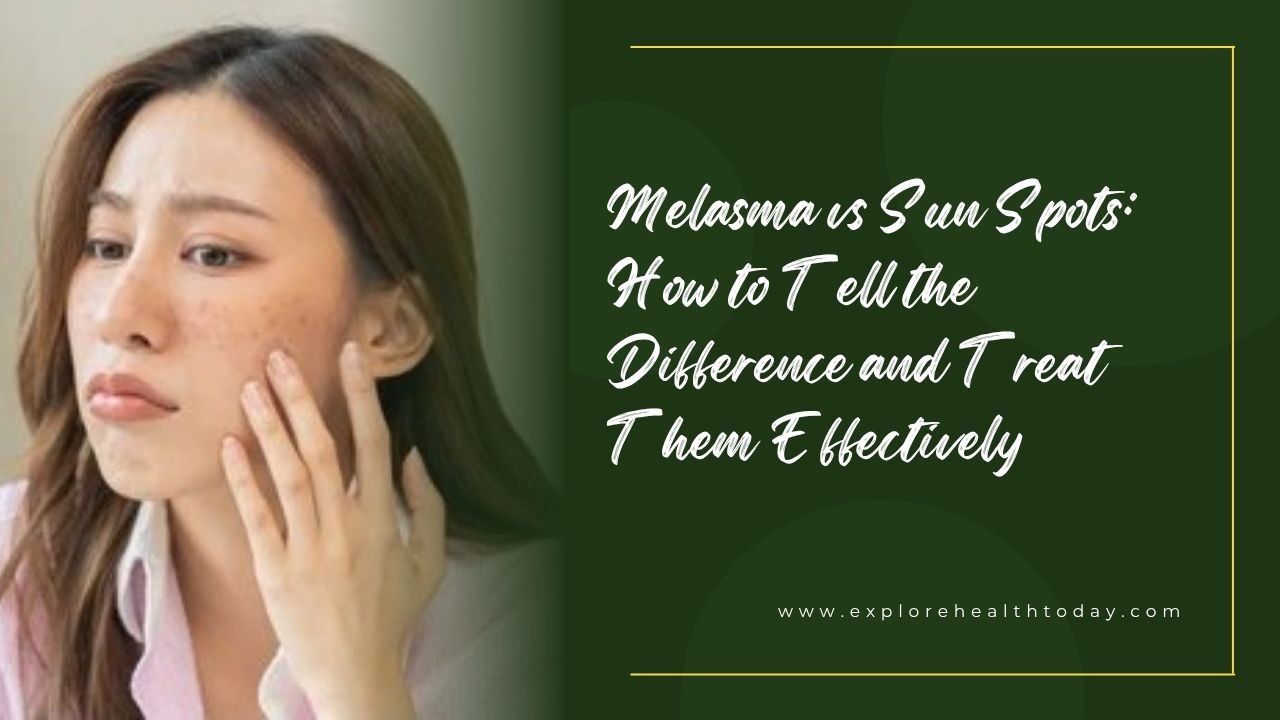Introduction: Not All Dark Spots Are the Same
Have you ever looked in the mirror and noticed patches of darker skin on your face or hands? You’re not alone. As we spend more time outdoors—or even just age naturally—skin discoloration becomes increasingly common. Two of the most misunderstood culprits? Melasma and sun spots.
Although they may look similar at first glance, melasma and sun spots are very different in origin, treatment, and prevention. Misidentifying them can lead to wasted time, ineffective skincare routines, and frustration.
In this blog, we’ll break down melasma vs sun spots in simple terms. We’ll explore what causes them, how to identify them correctly, what U.S. dermatologists are currently recommending in 2025, and the best treatment options available.
Melasma vs Sun Spots: At a Glance
| Feature | Melasma | Sun Spots (Lentigines) |
|---|---|---|
| Cause | Hormonal changes, sun exposure | UV damage from prolonged sun exposure |
| Appearance | Irregular brown or gray patches | Small, flat brown spots |
| Common Areas | Cheeks, forehead, upper lip, chin | Face, hands, shoulders, arms |
| Triggers | Pregnancy, birth control, heat, light | Cumulative sun exposure |
| Skin Type Affected | More common in darker skin tones | Affects all skin types |
| Treatment Time | Slower to fade, chronic | Responds well to treatments |
What Is Melasma?
Melasma is a common skin condition that leads to brown or gray-brown patches, mostly on the face. It’s often triggered by hormonal changes and is commonly referred to as the “mask of pregnancy.”
Causes of Melasma:
- Hormonal shifts (e.g., pregnancy, birth control pills)
- Sun exposure
- Heat and infrared light
- Genetic predisposition
- Certain medications
According to the American Academy of Dermatology, melasma affects over 6 million people in the U.S., with women making up about 90% of those affected.
Who Is at Risk?
- Women aged 20–50
- People with darker skin types (Fitzpatrick types III–VI)
- Those with a family history of melasma
What Are Sun Spots?
Sun spots, also known as solar lentigines or age spots, are flat, brown spots that develop over time due to long-term sun exposure. Unlike melasma, they are not hormone-related and tend to increase in number with age.
Causes of Sun Spots:
- Cumulative UV exposure
- Tanning beds
- Aging skin
- Light skin types are more prone
A CDC skin cancer report from 2024 highlights that more than 50% of adults over age 50 have at least one sun spot, especially those with a history of frequent sun exposure.
Where Do They Show Up?
- Back of hands
- Forearms
- Face and temples
- Upper back and shoulders
Melasma vs Sun Spots: Key Differences
Let’s dig deeper into how to tell them apart.
1. Pattern and Shape
- Melasma: Often appears as symmetrical patches on the cheeks or forehead.
- Sun Spots: Appear randomly and are smaller, isolated flat spots.
2. Response to Treatment
- Melasma: May take months or years to fade, even with treatment. Often recurs.
- Sun Spots: Usually respond quickly to laser, chemical peels, or topical treatments.
3. Triggers
- Melasma: Can flare up with hormone changes or even after being near heat or light—not just sun.
- Sun Spots: Only linked to UV damage.
4. Underlying Health Connection
- Melasma: Often tied to hormonal health and may indicate imbalances.
- Sun Spots: Cosmetic concern with no internal health implications.
How Are They Diagnosed?
Your dermatologist may use:
- Wood’s lamp examination to determine pigmentation depth
- Visual examination of the distribution pattern
- In rare cases, a skin biopsy to rule out malignancy
Tip: Don’t self-diagnose. Mistaking melasma for sun spots (or vice versa) can lead to using the wrong products—some of which might worsen your condition.
Treatment Options for Melasma
Topical Treatments:
- Hydroquinone (2–4%): Skin lightening agent, available by prescription
- Tretinoin + corticosteroids: Often combined for enhanced effect
- Azelaic acid or tranexamic acid: Gentler alternatives gaining popularity
Procedures:
- Chemical peels (superficial)
- Microneedling
- Low-energy lasers (only under expert care)
In 2025, U.S. dermatologists are increasingly recommending oral tranexamic acid for stubborn melasma cases, with promising results under clinical supervision (NIH study).
Ongoing Management:
- Daily broad-spectrum sunscreen (SPF 50+)
- Wide-brimmed hats and sun-avoidance habits
- Hormonal evaluation if recurring or persistent
Treatment Options for Sun Spots
Sun spots are easier to treat and usually do not return if protected from further sun damage.
Quick Treatments Include:
- Cryotherapy: Freezing with liquid nitrogen
- Laser treatments (e.g., IPL)
- Chemical peels with glycolic or salicylic acid
- Prescription retinoids or over-the-counter options with niacinamide and vitamin C
The Skin Cancer Foundation warns that some sun spots can evolve into precancerous lesions, so it’s wise to get them checked, especially if they change in size or color.
2024–2025 Skincare Trends in the U.S.
- Customized skincare regimens based on genetic testing and skin microbiome analysis are becoming mainstream.
- SPF moisturizers and UV-protective clothing sales have surged, especially in sunny states like Florida and California.
- Tele-dermatology services have expanded, with AI tools assisting early detection of pigmentation disorders.
- Mineral sunscreens and melasma-safe skincare products are seeing high demand among women aged 25–45.
Prevention Tips for Both Conditions
For Melasma:
- Avoid peak sun hours (10 AM–4 PM)
- Choose non-comedogenic, mineral-based sunscreens
- If on birth control, consult your doctor if pigmentation worsens
- Treat heat and light exposure (even from electronic screens) seriously
For Sun Spots:
- Daily SPF (even on cloudy days)
- Wear protective clothing
- Limit tanning beds and outdoor tanning
- Use antioxidants (vitamin C, E) in your skincare
When to See a Dermatologist
Make an appointment if:
- You’re unsure whether it’s melasma or a sun spot
- You notice new, fast-growing, or irregularly shaped dark spots
- OTC treatments aren’t working after 2–3 months
- You’re pregnant or planning to be and have facial pigmentation
Conclusion: Melasma vs Sun Spots—Know the Difference, Protect Your Skin
Understanding the difference between melasma and sun spots is more than just a skincare question—it’s about treating your skin wisely and preventing long-term issues. While both conditions involve pigmentation, their root causes and treatments are very different.
By identifying your skin concerns accurately and adopting the right skincare approach, you can fade existing spots and prevent new ones from forming.
Call-to-Action: Don’t Let Pigmentation Take Over Your Confidence
If you’re seeing dark spots and aren’t sure whether it’s melasma or sun damage, now’s the time to act.
Book a consultation with a board-certified dermatologist and get a clear diagnosis. The sooner you start the right treatment, the sooner you’ll see results—and feel confident in your skin again.
About ExploreHealthToday.com
ExploreHealthToday.com was created to be a one-stop resource where readers can find up-to-date, well-researched articles on a variety of health topics. From nutrition and wellness to lifestyle and mental health, we strive to provide reliable information to help you make informed decisions about your well-being.
We believe that good health starts with good information, and our mission is to empower our readers with knowledge they can trust.
Visit us at ExploreHealthToday.com to learn more.





